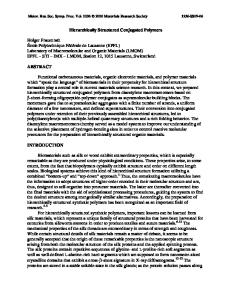De novo synthesis of bifunctional conjugated microporous polymers for synergistic coordination mediated uranium entrapme
- PDF / 3,045,821 Bytes
- 9 Pages / 612 x 808 pts Page_size
- 57 Downloads / 321 Views
De novo synthesis of bifunctional conjugated microporous polymers for synergistic coordination mediated uranium entrapment Boxuan Yu1,2,3,§, Lei Zhang1,4,§, Gang Ye1,5 (), Qingzhi Liu4,6, Jiongli Li2,3, Xudong Wang2,3, Jing Chen1,5, Shengming Xu1,5 (), and Shengqian Ma4,† () 1
Collaborative Innovation Center of Advanced Nuclear Energy Technology, Institute of Nuclear and New Energy Technology, Tsinghua University, Beijing 100084, China 2 Beijing Institute of Graphene Technology, Beijing 100094, China 3 Beijing Institute of Aeronautical Materials, Beijing 100085, China 4 Department of Chemistry, University of South Florida, 4202 E. Fowler Avenue, Tampa, FL 33620, USA 5 Beijing Key Lab of Radioactive Waste Treatment, Tsinghua University, Beijing 100084, China 6 College of Chemistry and Pharmaceutical Sciences, Qingdao Agricultural University, Qingdao 266109, China † Present address: Department of Chemistry, University of North Texas, 1508 W. Mulberry St, Denton, TX 76201, USA § Boxuan Yu and Lei Zhang contributed equally to this work. © Tsinghua University Press and Springer-Verlag GmbH Germany, part of Springer Nature 2020 Received: 7 September 2020 / Revised: 19 October 2020 / Accepted: 29 October 2020
ABSTRACT This work reports a de novo synthesis of novel bifunctional conjugated microporous polymers (CMPs) exhibiting a synergistic-effect involved coordination behavior to uranium. It is highlighted that the synthetic strategy enables the engineering of the coordination environment within amidoxime functionalized CMP frameworks by specifically introducing ortho-substituted amino functionalities, enhancing the affinity to uranyl ions via forming synergistic complexes. The CMPs exhibit high Brunauer–Emmett–Teller (BET) surface area, well-developed three-dimensional (3D) networks with hierarchical porosity, and favorable chemical and thermal stability because of the covalently cross-linked structure. Compared with the amino-free counterparts, the adsorption capacity of bifunctional CMPs was increased by almost 70%, from 105 to 174 mg/g, indicating evidently enhanced binding ability to uranium. Moreover, new insights into coordination mechanism were obtained by in-depth X-ray photoelectron spectroscopy (XPS) analysis and density functional theory (DFT) calculation, suggesting a dominant role of the oxime ligands forming a 1:1 metal ions/ligands (M/L) coordination model with uranyl ions while demonstrating the synergistic engagement of the amino functionalities via direct binding to uranium center and hydrogen-bonding involved secondary-sphere interaction. This work sheds light on the underlying principles of ortho-substituted functionalities directed synergistic effect to promote the coordination of amidoxime with uranyl ions. And the synthetic strategy established here would enable the task-specific development of more novel CMP-based functional materials for broadened applications.
KEYWORDS conjugated microporous polymers, uranium, adsorption, synergistic coordination, density functional theory
1
Introduction
Data Loading...











